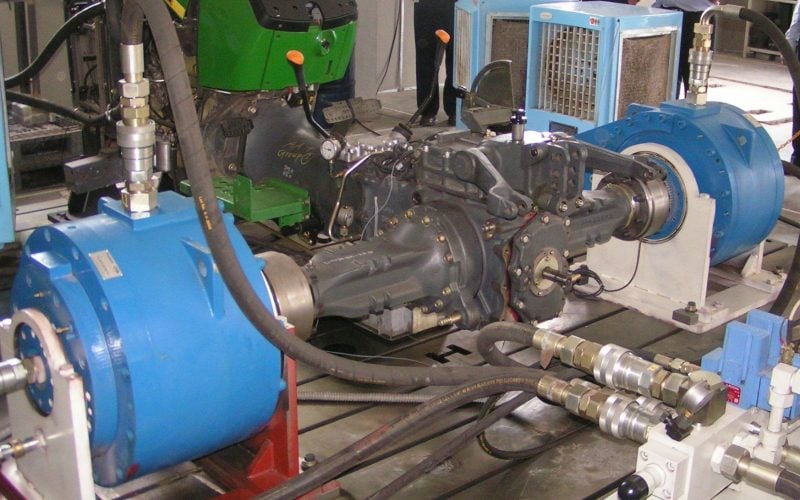High torque, low-speed testing is often a challenge for dynamometers equipped with traditional load brakes. Testing which requires the brake to absorb significant horsepower and torque but at low to very low speed can result in cogging, chatter, or stick slip, producing inaccurate data if any data is captured at all. In a best-case scenario, it may mean that testing needs to be performed again – worst case scenario means that the data cannot be obtained. Oil Shear brakes however, are uniquely designed to absorb these extreme torques at very low speed (down to zero rpm), allowing dynos to accurately capture data at these critical junctures.
Where does Oil Shear fit in the testing realm?
In the automotive/transportation market, Positorq Oil Shear Load Brakes are helping customers acquire test data relating to life cycles, shock loading, and even emissions testing/certification, engine performance, and overall machine life and performance.
This type of test equipment is typically connected to the final output of the device or machine to be tested. Positorq Oil Shear Load Brakes are being used to test snowmobiles, forklifts, 2-wheel, 4 wheel, or 6 wheel, even track drive agricultural and construction vehicles such as dozers or graders, and commercial truck axles.
Additionally, outside of the automotive/transportation segment, they may be used for testing of military equipment (new and rebuilt certification) including helicopter transmissions, gun turrets, winches and hoists. Deep hole boring motors, railroad track repair equipment, cement finishing machinery, underground mining equipment, torque wrenches and other power tools, winches, gear boxes, and lawn and garden machines have also benefitted from this robust and proven technology.
If not Oil Shear, then what? – A look at the alternatives
Potential load absorbing systems that are often considered for use in dynos include AC electric motors, Eddy Current absorbers, water brakes, and dry friction brakes. These all have advantages and dis-advantages. Although they are great for many of the higher speed applications, they have significant issues with the low speed high torque applications.
Electric absorbers (AC and Eddy Current) typically operate at higher speeds than the test item, which requires a speed increasing drive to be inserted into the system. This adds inertia and possibly gear noise that interferes with the test data. The high horsepower may also require the addition of water cooling, that introduces problems with corrosion and scale buildup in the internal parts of the motor. As the torque increases, so does the size of the electric absorber required, making them cumbersome and expensive. They also require sophisticated technology which may have to be routinely updated as technology continues to evolve.
Water brakes are inexpensive compared to many systems but provide less control. They also require higher speed in order to apply torque, with the same drawbacks mentioned above. While they are not well suited for low-speed, high-torque environment, Water brakes tend to perform better for continuous testing of higher speed applications such as engine dynos, turbines, and other high-speed load testing.
Another means of absorbing the dyno load is dry friction brakes. However, as the torque demands increase, so does the size of the dry friction brake, which adds inertia to the system. Inertia can be a good thing or a bad thing. Often inertial wheels are added to the test equipment; however, internal inertia may be too much or too little. The best option is to have low inertia in the absorber and allow the inertia to be added as needed. Dry braking systems do not dissipate heat well, so water cooling through the brake is often required. The heat also causes degradation of the friction material (wear, surface cracking, glazing, and warping) which in turn changes the torque transmitted, requiring frequent maintenance and adjustment. In addition, particularly at low speed, they often stick slip, chatter, get very noisy, and produce poor test results.
The Positorq Dynamometer Load Brakes are specifically designed for low speed (down to zero rpm), to run smoothly, quietly, with superior controllability. Their compact design lends itself to many mounting styles, including direct mounting to the output axle for final drive loading which is the most common.
Though the basic Positorq brakes have been in existence for many years (a dyno load brake was recently sent in for repair after operating for 40 years), many improvements developed over the years make them compatible with the newer, high technology, testing controls and data acquisition.
In the past, load brakes utilizing Oil Shear Technology were sometimes paired with an electric load brake, with the Force Control product performing the “heavy lifting” while the electric system handled the more precise trim control. Today that is often reversed. Due to the improvements in control technology and new brake actuation design, the Positorq Oil Shear brakes are being used for precise trim control.
Force Control Industries can furnish a complete test stand including base fabrication, controls, data acquisition, and support. This can be a benefit to many companies who often build testing facilities in-house, but either lack the ability or time to design and support the complete system. Force Control will work with customers to provide any level of design and support from just a load brake, to design and build of the mounting structure, to a complete control system.

